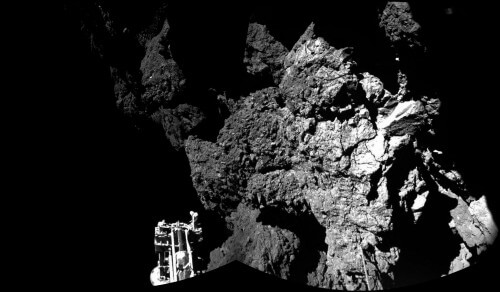The Philae lander (PHILAE) transmitted a lot of data collected by its instruments for about a minute and a half, through the mother spacecraft Rosetta

European Space Agency scientists have received a signal of life from the Philae lander, seven months since contact with it was lost, shortly after it completed the first ever landing on a comet. "Pillai" was equipped with batteries that were supposed to last 60 hours, and then was designed to generate energy from its solar panels. However, due to a malfunction in the landing, it ended up in the shadow of a large rock, and did not receive enough light to generate electricity after its batteries were exhausted.
European Agency scientists expressed hope that the lander will return and be exposed to light as Comet Churyumov Gersimenko approaches the Sun. Today, as mentioned, contact was made with the lander for about a minute and a half, during which the lander sent a lot of data collected by its instruments, through the mother spacecraft "Rosetta", which continues to circle the comet. The scientists hope that the connection with the lander will stabilize as the comet gets closer to the sun in the coming weeks. "We hope to restart all the instruments in the coming days and apply again to collect data on the comet from the ground, alongside those collected from above by the mother spacecraft", says the European Agency scientist, Mark McCochrian to the BBC:
"The interesting thing is that the comet is now much more active, due to its proximity to the Sun, and we hope that this activity will provide us with new information about comets."
In the coming days, the scientists and engineers will try to check if the lander's instruments are working properly, and were not damaged during the prolonged freezing period. Among other things, they hope to complete the main task that "Pilay" did not complete with the landing - to drill into the comet's soil, and analyze the composition of the samples.
Landing on the comet - special coverage on the Hidan website
- An interview with Kalim Churiomov, from the comet explorers
- The wisdom of the crowds helped discover the jump of the Philae lander and its final landing place on the comet
- Philae completed her initial mission and went into forced hibernation
- Philae landed on her side, still sending impressive pictures
- Philae settled on a rocky surface but did not anchor to the ground of the comet
- Assessment as to the cause of the disruptions: Philae landed, then took off again and landed at a different point
- ESOC director Paolo Perry in an interview with the science website: Rosetta is not a typical space mission
- European Space Agency control room director: "Philae on the comet" Update: apparently the anchors did not stick to the ground
- The European Space Agency has revealed the photograph of Philae's farewell to Rosetta before landing on the comet
- Update: A signal was received from the lander. The director of the landing operation of the Philae spacecraft to the science site: one of the gas tanks intended to assist in the landing did not open, but we are sure that the landing on the comet will be smooth

3 תגובות
Zuri
Already GPS satellites must use both special and general relativity. Beyond that, an accurate calculation of the position of the star over a long distance and over a long period of time requires complex calculations.
In order to land such a lander on a planet, only Newton's laws are required, or is it necessary to enter a more complex field in science?